Home Safety Checklist For Austin
Keeping safe in your residence should be your number one concern. But are you forgetting one or two key safety items? Look over this home safety checklist for Austin and discover where your living space needs some work.
This guide begins with some whole-house safety items, and then we delve down on a room level. Then, call (512) 641-0712 or complete the form below for additional information.
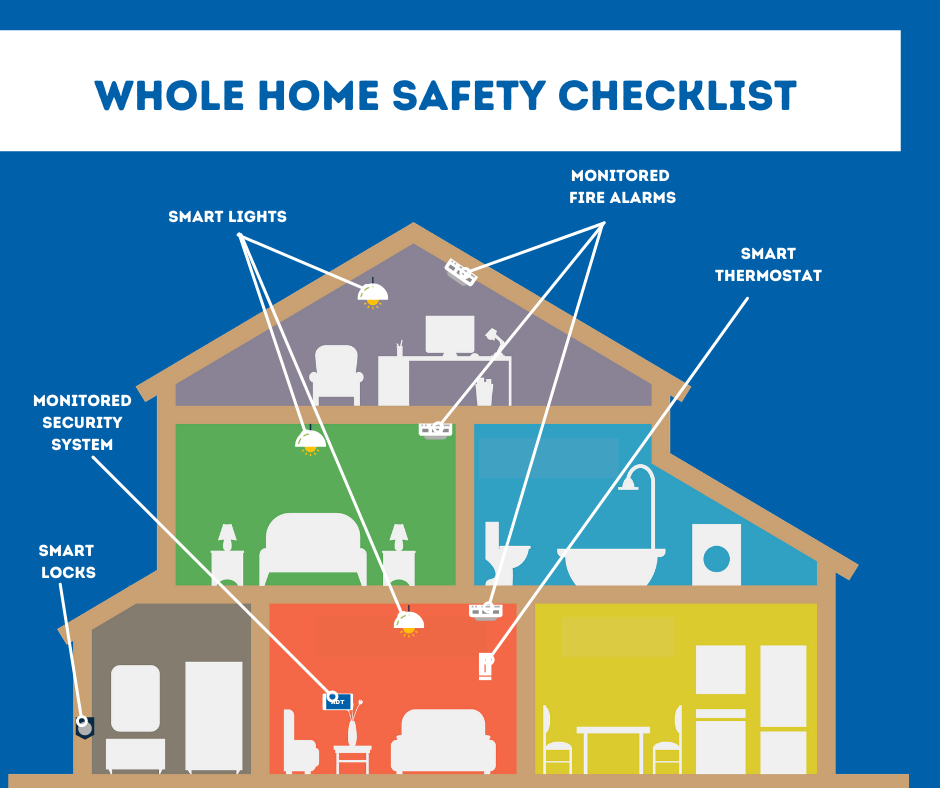
Essential Home Safety Checklist for Austin
While you may want to use a room-to-room approach to home safety, there are some items that work for a lot of your rooms. These devices can talk to each other through a wireless hub, and often can respond to other components. You might also control each of your home safety components using a smartphone app, like ADT Control:
-
Monitored Home Security System: Each one of your doors and windows should have a sensor that warns your family to a break-in. As the alarm goes off, your monitoring team picks up the alert and quickly sends the police or fire department.
-
Smart Lights For Each Room: Sure, you can program your smart lights to become more efficient. But smart lights can also allow you to keep safe during an emergency. Have your smart bulbs flash on when a security alarm goes off to shoo off robbers or brighten a path to a safe area.
-
Smart Thermostat: Like your smart lights, a smart thermostat in Austin should save you 10%-15% in gas and electric spending. But it also can flip on your exhaust fan when your alarms senses a fire.
-
Monitored Fire Alarms: It’s code that you will have a fire alarm on every level. You can increase your fire game by utilizing a monitored fire alarm that looks for both heat and smoke, and alerts your round-the-clock monitoring team when it detects a fire.
-
Smart Door Locks: Every door that uses a keyed lock can use a smart door lock. Now you may preset codes to each family member and receive notifications to your mobile device when the locks are activated. Your smart lock can even automatically turn off, helping you to quickly leave during an emergency.
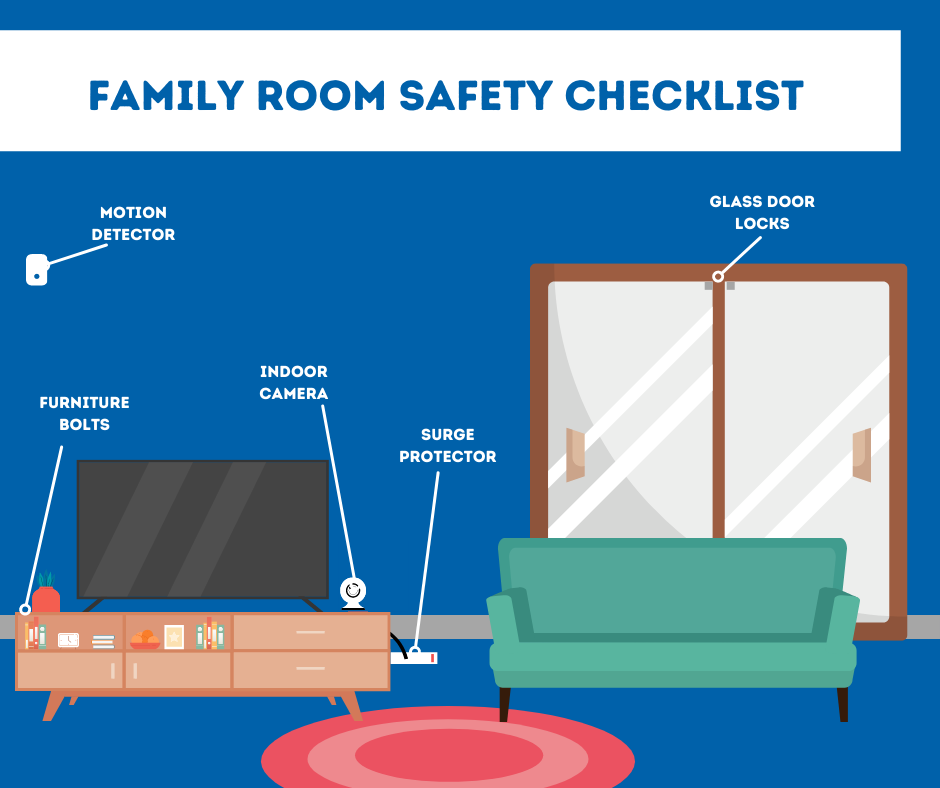
Family Room Safety Checklist For Austin
You’ll hang out most in your living room, so it can be the perfect room to start making your home a safer place. Electronics, like a big screen or video games, usually are located in your family room, making it a popular room for burglars. Begin with placing a motion detector or security camera in your room, then take a look at all these ideas:
-
Motion Sensors: By installing motion sensors, you’ll get a loud alarm if they sense suspicious movement in your living room. You’ll want motion detectors that aren’t set off by pet movements or you’ll get a tripped alarm each time your dog roams by for a midnight stroll.
-
Indoor Camera: An indoor security camera gives you a visual on your living room. Watch constant streams of your room so you can find out what’s downstairs through the mobile app. Or chat with your family when they arrive home from school by using the two-way talk feature.
-
Surge Protector/Cord Maintenance: Safeguard those electronics and quit overburdening your electric system with a surge protector. For extra energy-efficiency, use a smart plug with a surge protector included.
-
Furniture Attached To The Wall: If you have babies or toddlers, you’ll want to bolt your entertainment center or other heavy furniture to the wall. This is extra important if your family room uses carpet that might make furniture extra unstable.
-
Special Locks For Sliding Doors: If your family room has a glass door that leads to a backyard, deck, or outside porch, you already know that the lock is fairly worthless. Install an enhanced lock, like a bottom bar or locks that secures the door to the top and bottom of the opening.
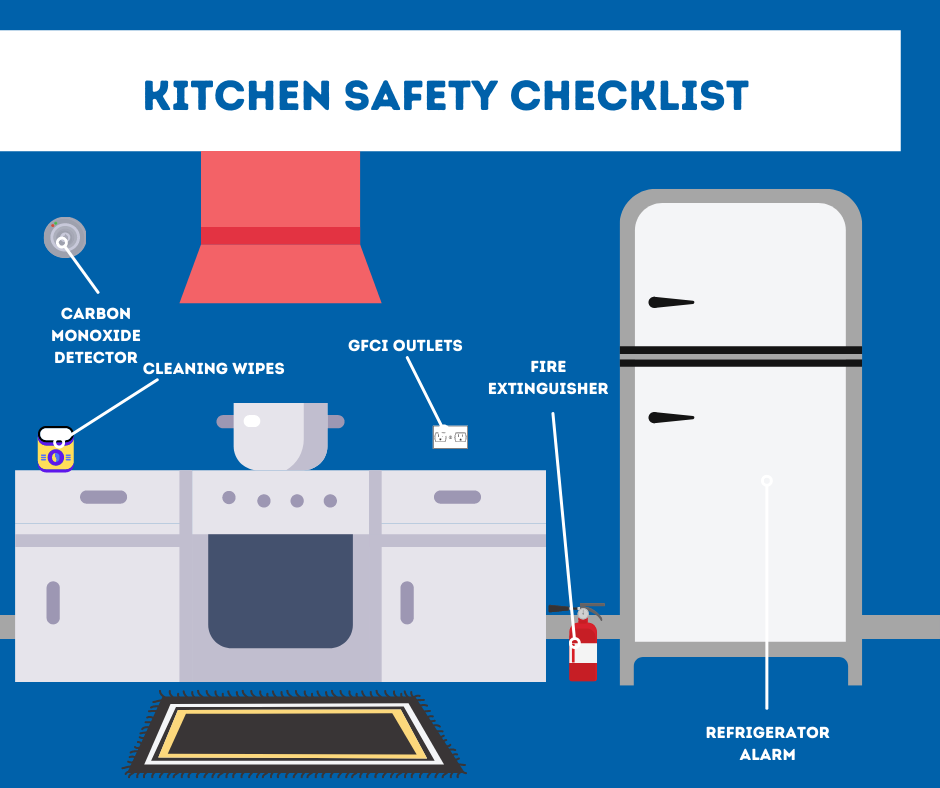
Kitchen Safety Checklist For Austin
The kitchen has plenty of items that can bring comfort and safety to your house. Some of these objects are also simple to add and should be found in the a retail store:
-
Fire Extinguisher: Fire can spring up from a neglected frying pan or an errant grease splatter. Always have a fire extinguisher at the ready for any cooking mishaps.
-
GFCI Box On Each Outlet: A circuit interrupter outlet should be used everywhere there’s nearby water to prevent an electric shock. That includes the plug outlets close to your kitchen counter and sink. Since 1987, it’s been code to have one circuit interrupter outlet per dedicated circuit. But each one of your outlets will go if one outlet sees a surge, so you’re going to want to install an unchained GFCI on each outlet.
-
Monitored Carbon Monoxide Detector: A carbon monoxide detector is handy in spaces that use natural gas for the oven and stove. If your gas lines malfunction, the CO detector will emit a loud, buzzing siren and contact your monitoring expert.
-
Disinfectant Wipes Or Spray: The biggest safety problem in the kitchen is the invisible bacteria and contamination from raw meat and dairy. Always have antiviral wipes or an antibacterial spray to clean your counters when cooking.
-
Refrigerator Alarm: The items in your fridge have to stay at a constant temperature to be safe to use. If you accidently leave the fridge or freezer door open, then a constant beep will remind you to close the door. Some fridges come with a pre-installed alarm, some won’t, and you’ll have to pick up a refrigerator alarm from online.
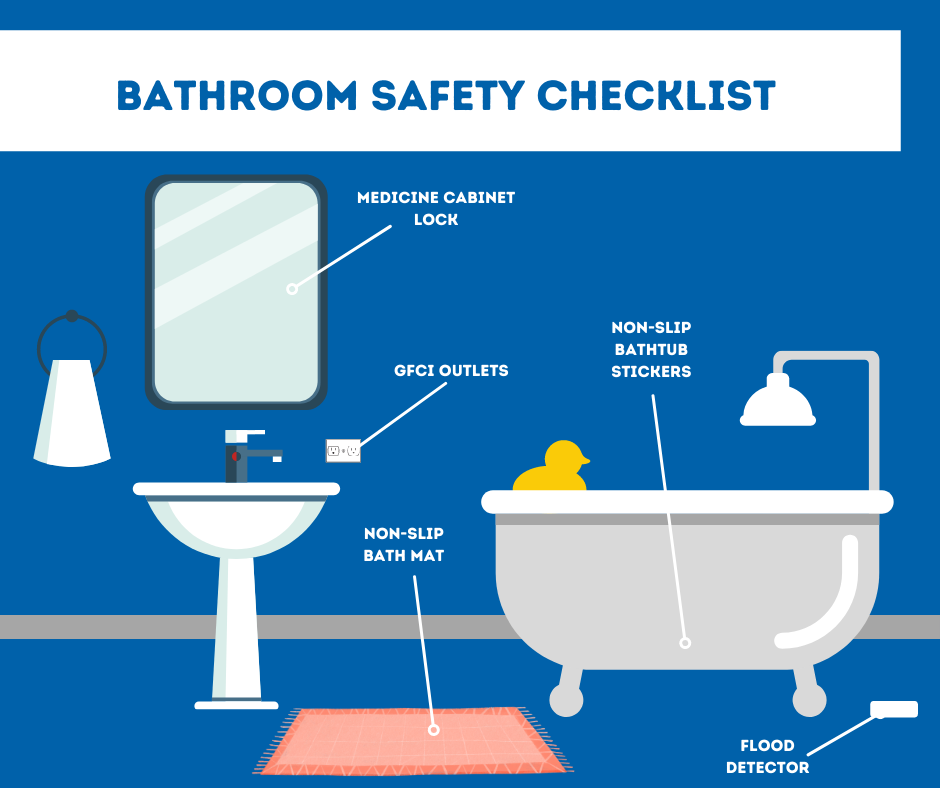
Bathroom Safety Checklist For Austin
Just because there’s not a bunch of square footage in your bathroom there’s still safety issues. From water problems to medicine care, here are a few safety improvements for your bathroom:
-
Flood Detectors: A leaking toilet or tub can cause an expensive amount of water damage. Find leaks early with a flood detector and save hundreds to thousands of dollars from renovations.
-
Textured Shower Mats: A fall in the bathroom can be a painful occurrence, causing cuts, bruises, or broken bones. Make sure you steer clear from these problems with a non-slip bathroom mat for your wet feet.
-
Textured Bathtub Strips: Another water hazard, a bathtub can be a slippery place to move in. It’s a good idea that every tub has some non-slip stickies so your feet have a rough patch to gain traction.
-
Medicine Door Latch: If you have young kids or a family member with memory difficulties, you should take extra care regarding prescribed medicine. Hide away your bottles by getting a medicine cabinet with a child-proof lock.
-
GFCI Circuits: While installing better outlets in the kitchen, you should also install a surge protecting GFCI outlet on each bathroom outlet. This will stop the flow of the electricity if water splashes on them or you have a harmful jolt from a hair dryer or curling iron.
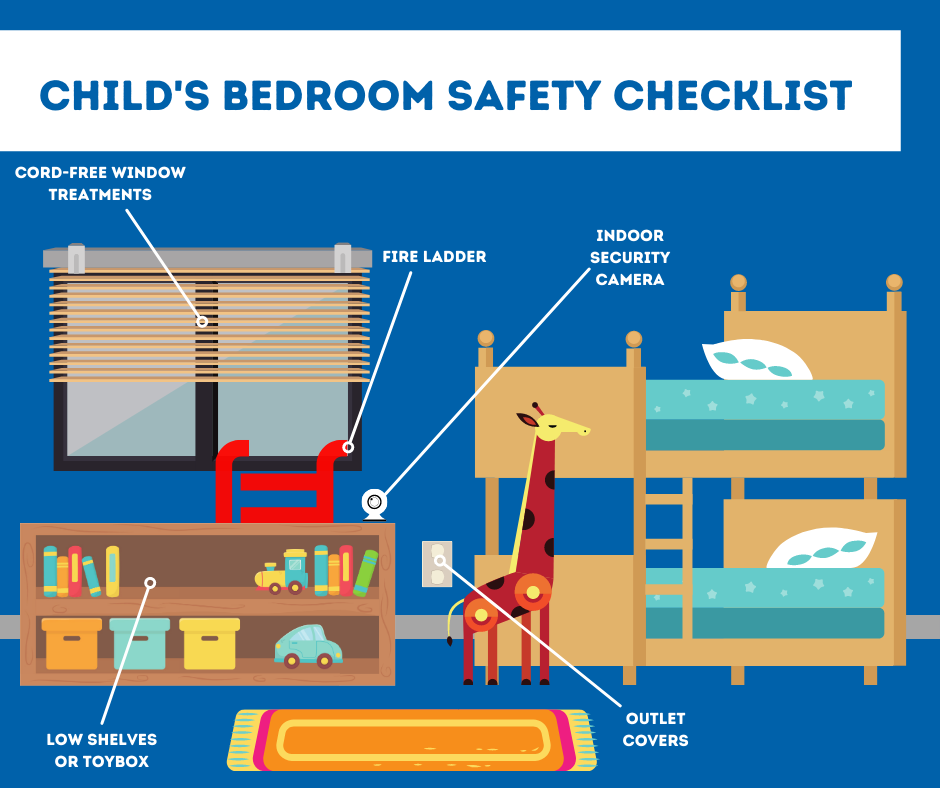
Child’s Bedroom Safety Checklist For Austin
A child’s bedroom should counterbalance safety with accessibility. If their window coverings or other things are safe but difficult to manage, then your kids may try unsafe methods -- like shimmying up a dresser -- to open them. Here are 5 easy, yet safe, ideas:
-
Cordless Window Coverings: Safety professionals have identified cords from shades and blinds an unsuspecting danger for kids and pets. Use motorized blinds or shades that kids can easily manage through a remote control. Or even better, connect your motorized treatments to your ADT smart hub so they rise automatically when the sun comes up, and lower at bedtime for an easier sleep.
-
Tableside Security Camera: A security camera sitting on your toddler’s desk or dresser can behave just like a high tech baby monitor that you can watch from a mobile device. And if they need something, they can use the two-way talk feature on the camera.
-
Outlet Plug Covers: While every outlet should have protective covers on them when you have little children, this is especially needed in their bedroom. It’s the one room in your house where your children will most likely be solo without consistent additional supervision.
-
Window Fire Ladder: If you use bedrooms on the second story, then you will want to install a window fire ladder. These should help a young one get out of their room in case the stairs or downstairs are on fire. Remember to go over how to employ them a few times a year.
-
Toy Chest Or Low Shelves: It’s interesting to think about a toy chest as a safety component, but you’ll get it if you’ve ever walked on a Lego in your stocking feet. A clutter-free floor means a quick retreat if there’s a safety or security event.
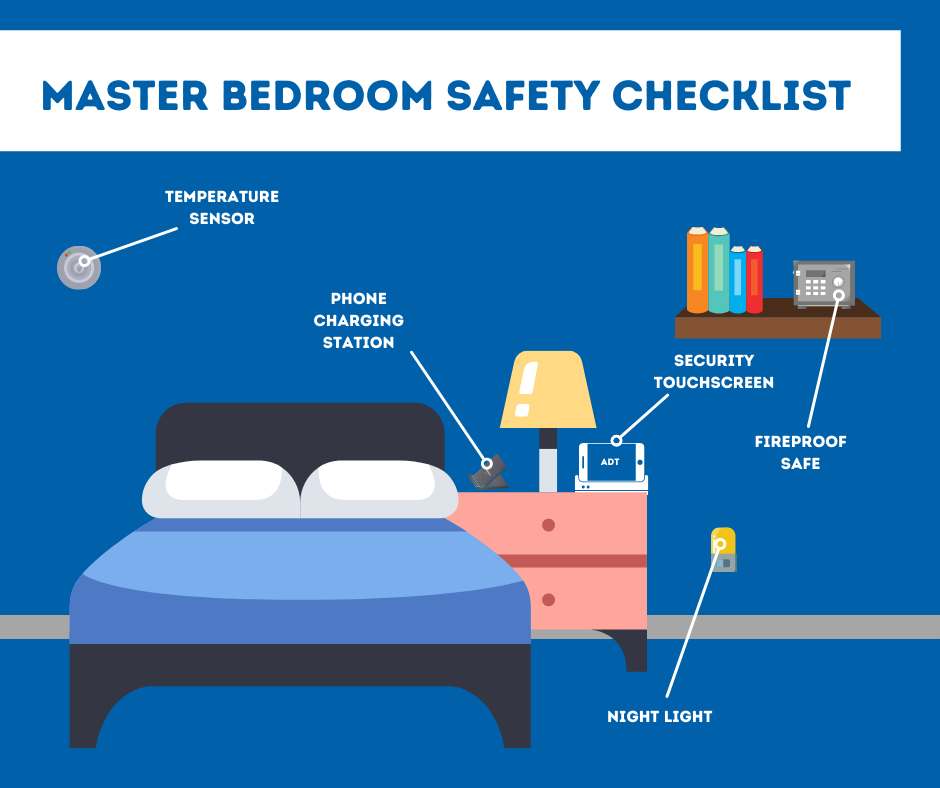
Master Bedroom Safety Checklist For Austin
Your bedroom should be a refuge, so let your safety devices make you more responsive when there's an emergency event. After all, being wrenched awake by a wailing buzzer can be confusing.
-
Home Security Touchscreen: Having a touchscreen on your nightstand helps you know what’s what that noise was without jumping out of bed. You could always use your ADT phone app but, the large touchscreen is often faster to use when you’re bleary-eyed and confused.
-
Device Charging Area: We use our phones for so much now alarm clocks, internet searches, time wasters, and maybe even phones. The only problem is that a dead phone will cut us off from the outside world if something goes wrong. To keep it nice and ready, a an easy-to-use charging station is an essential.
-
Nightlights Or Voice Activated Smart Lights: A small light can calm you when you’re bolted awake from an alarm or unexpected noises. If you won’t drift off to sleep with a nightlight, install smart lights in your bedroom and hall. Then you can have light anytime with a push of a button or vocal command.
-
Fireproof Safe: Keep your vital documents like insurance cards, medical information, or a spare checkbook in a fireproof safe. This can be a large one that is located out of the way or a slender portable lockbox that you can snatch on your way out during an emergency event.
-
Heat Sensor: The drawback with a master bedroom is that they might feel too stuffy or be frigid because they are located far from the thermostat. A heat sensor can communicate to your smart thermostat so you can have a pleasant, restful sleep at a wonderful temperature.
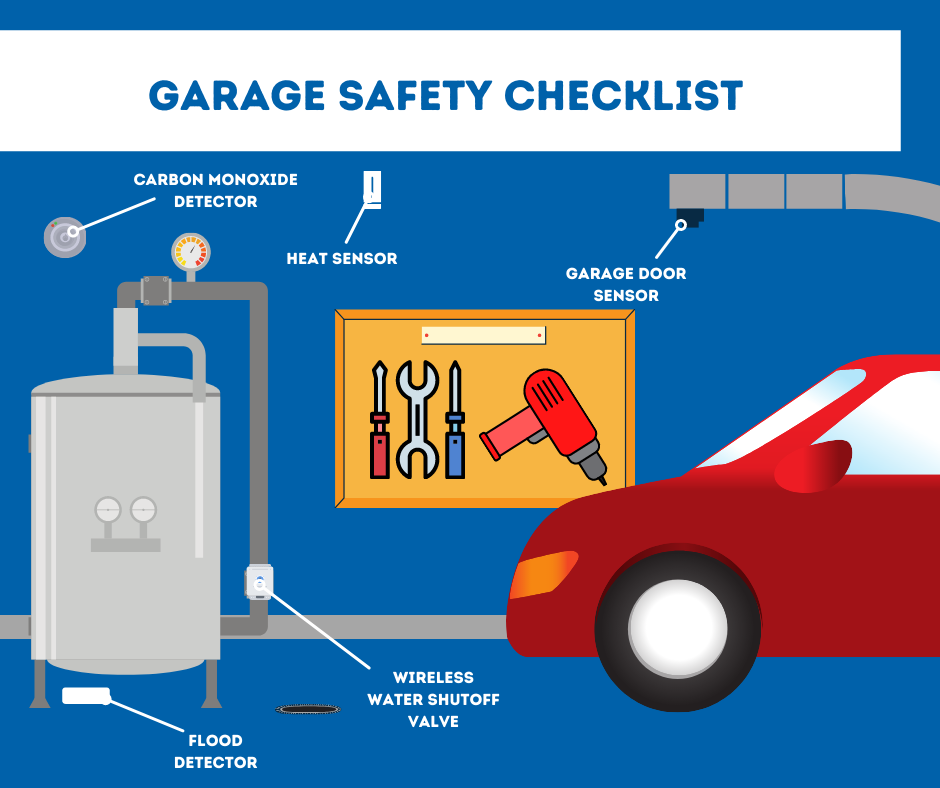
Basement/Garage Safety Checklist For Austin
Most safety problems in the basement or garage have to do with your water or furnace. Seeing problems before they start can prevent larger emergencies in the future. So, as you walk around your garage or basement, check over these safety items:
-
Flood Detector Or Sump Pump Alarm: Installing a flood alarm in back of your water heater and sump pump can prevent you from discovering a pond when you go into your garage or basement. Do you really want to lose your day getting rid of standing water?
-
Carbon Monoxide Alarm: It’s smart to hang a carbon monoxide detector in a place where a CO leak can happen. If you use a gas furnace, you should hang a detector in the same room as your inbound pipes.
-
Remote Water Shutoff Valve: If your water sensor finds a hot water heater leak or a broken pipe, then you need to cap the main water pipe quickly. With a WiFi shutoff valve, you can turn off your water flow from any mobile device. That’s helpful when you’re visiting relatives and receive an emergency leak text on your phone.
-
Garage Door Sensor: Leaving the garage open brings about all sorts of headaches. You can waste HVAC energy through that large opening, and rodents or thieves can just walk in. A sensor will text you about a forgotten garage door and allow you to close it through the app.
-
Heat Sensor: A temperature alarm in your basement or garage is handy if you fret about your pipes freezing. The temperature in these areas can be drastically different than the main part of the home, so you will want to maintain a constant look on the temp through your mobile app.
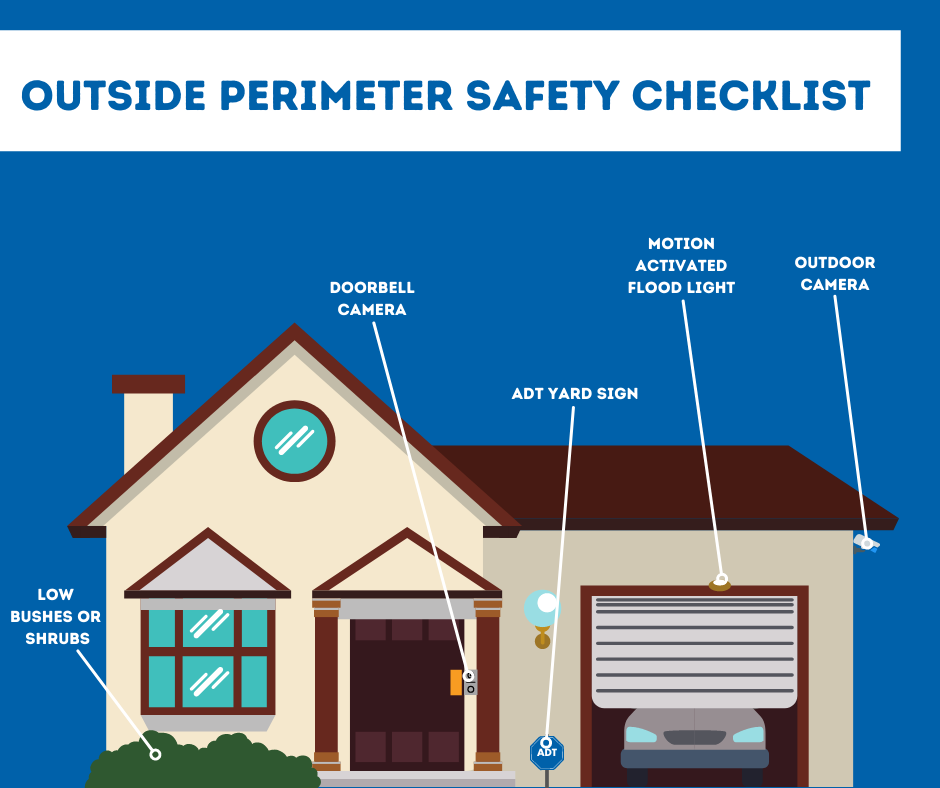
Outside Perimeter Safety Checklist for Austin
Your foliage, drive, and front step are just as imperative to secure as the inside of your home. Try this checklist to create a safe outside:
-
Doorbell Security Camera: See who’s arrived at the the front step before you answer it and talk to guests. Get a visual on deliveries and look at video clips if they disappear.
-
Outdoor Camera: You can place outdoor security cameras to guard against late night movement in your back yard. These cameras are especially useful in areas where you may not have a window -- like a side yard or by the garage.
-
Low Shrubs: High foliage can create some privacy, but they also block your line of sight of the outside. Don’t offer potential burglars a place to hide. Plus, tall shrubs or greenery against your home can clog gutters and summon bugs.
-
ADT Signs And Decals: One of the largest deterrents for a break-in is alerting aspiring intruders that you have a state-of-the-art home security system. An ADT yard sign by the main walk and a window cling will alert ne'er-do-wells that they ought to keep walking to an easier target.
-
Motion Triggered Porch Lights: Light is the largest enemy to those who lurk in the dark. Motion-activated lighting on your porch, garage, or deck can shoo possible intruders away. They also help you work the locks when you arrive back home late at night.
Contact Secure24 Alarm Systems To Help You Finish Your Home Safety Checklist for Austin
While Secure24 Alarm Systems can’t help you with non-security devices on your Austin home safety checklist, we can install a customized home security. With easy-to-use devices and ADT monitoring, we can customize the best system for your house’s needs. Simply phone (512) 641-0712 to get started or fill out the form below. Or personalize your own system with our Security System Designer.
